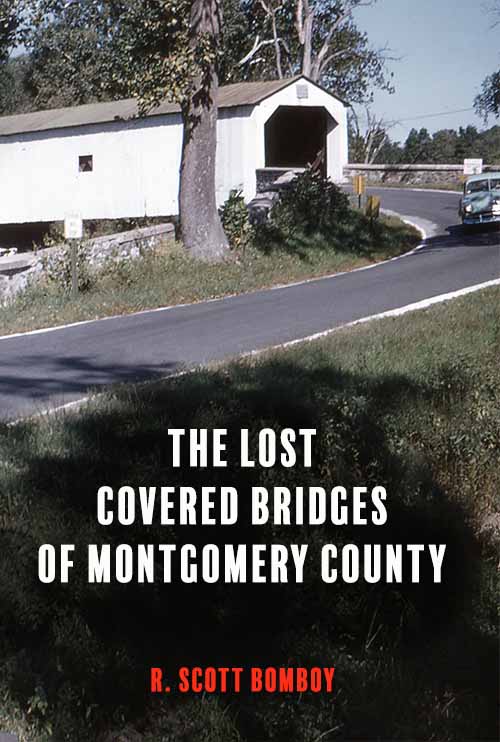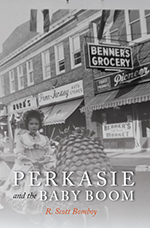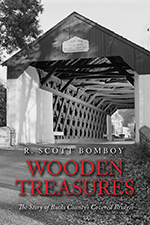Editor’s Note: Allied forces push toward Berlin and Tokyo at a great price in early 1945.
Headlines in World War II’s final year in Perkasie were again dominated by sacrifices made overseas and at home and the debate over the Borough’s post-war fate.
Early January 1945 started with the news that PFC Walter Moyer, only one of two married men from Silverdale in the conflict, had been killed in Germany. Moyer was well-known in the community and president of the Silverdale Fire Company. PFC Warren Forgan of Seventh Street in Perkasie also had been captured at the Battle of the Bulge. On January 25, 1945, three other soldiers from the Pennridge region were unaccounted for at the Battle of the Bulge, followed by two more the following week.

Battle of the Bulge, 1945
At the same time, more active military members were coming home from their deployments. Many had worked the area’s biggest plants such as the U.S. Gauge in Sellersville and the Royal Pants Company in Perkasie.
Early February 1945 also saw the death of one of Perkasie’s best-known merchants. H.D. Moyer ran the Borough’s oldest business, the country store across from the South Perkasie Hotel that dated back to 1845. Moyer died when his car slid into a truck in Allentown during icy driving conditions.
Starting in late February, more news of military casualties arrived as the Allied forces closed in on Germany and Japan. Perkasie’s Sergeant Edward Senior was killed in action after his B-25 bomber was lost over the Philippines, while former Sell-Perk High School Class of 1941 president Russell Fretz Jr. died fighting in the Netherlands. In March, PFC Frank Sampson of Ninth Street in Perkasie was killed in action in Germany. Also in March, Mary Schatz, the daughter of Perkasie Police Chief James Schatz, became the first Navy WAVE from Perkasie to be deployed outside of the continental United States when she was sent to Hawaii.

Local Waves Head To Hawaii
By April 1945, the American public expected the imminent fall of Germany as Allied forces headed toward Berlin. The mayors of Perkasie (Harleigh Apple) and Sellersville (J.A. Kooker) proclaimed a day of prayer when victory in Europe was declared, but no public parades would be held until a victory was secured against Japan.
That day would not arrive for another month. On the home front, the community focused on fundraising for the Red Cross, and the Rotary and Kiwanis clubs sponsored a clothing drive for war refugees in Europe. On Saturday, April 15, 1944, all community businesses closed early so the public could listen to coverage of the funeral of President Franklin D. Roosevelt in Washington, D.C.
The official proclamation of victory in Europe came on May 8, 1945, and as planned, the moment was marked quietly at 9 a.m. after local sirens alerted the public to the long-awaited V-E Day. All public facilities closed as well as businesses, and church services were held that night. The sober reality, the Perkasie News-Herald noted, was that victory over Japan would require a “vast outpouring of resources grim toll of life.”

PFC Henry L. Young
On June 21, 1945, the fate of one of the missing Perkasie boys, made headlines in one of the war’s tragedies. Private Henry L. Young, who had spent two and a half years in a Japanese prisoner of war camp, died along with 1,775 other American captives when his ship was sunk by a U.S. Navy submarine.
The Japanese used a tactic to transport military prisoners on “hell ships” that were unmarked troop vessels within a convoy. Young was on the Arisan Maru, which had left the Philippines on October 20, 1944, on a trip toward Formosa, in a mission to keep the POWs from liberation by General Douglas MacArthur’s American troops.
Boatswain Martin Binder, one of the nine Americans who survived the sinking, later described the tragic events. Two American torpedoes hit the ship on October 24, 1944. The Japanese abandoned ship, Binder said, and then cut the ships’ rope ladders to prevent the POWs from escaping. Binder was able to get into the water wearing a life vest, and he witnessed Japanese destroyers in the convoy turning away from the Arisan Maru as it sank. A Japanese merchant ship eventually picked up Binder. News then came that another serviceman, PFC Warren Forjan, had died in April while in Nazi custody after he was forced to work on a railway crew. A fellow prisoner who had been liberated from the same camp knew about Forjan’s fate.
Back home, local officials started planning for the post-war economy. The Perkasie Chamber of Commerce urged Perkasie and Sellersville to work together to build a regional airport and to improve the conditions of local roads. As the war continued into August 1945, communities put these plans on hold as all thoughts were focused on the upcoming invasion of Japan.

Truman Announces End of War
The attacks on Hiroshima and Nagasaki in early August held promise the war would soon end. On August 13, Perkasie’s leaders met to discuss if a celebration was appropriate if news came from President Harry Truman of a Japanese surrender. The general thought there would just be a somber celebration like the ones held on V-E Day. However, at 7 p.m. on August 14, President Truman made the announcement, which set off hours of spontaneous celebrations in both towns, with the crowd spilling into Menlo Park. On the following day came a large parade featuring residents of Perkasie, Silverdale and Sellersville marching through the three Boroughs. Special church services ended that day.
After the official end of hostilities, the rationing of gasoline and most food products also ended, but life would not return to normal in the short term, and the “new normal” would be much different in the post-World War II world. Starting in August 1945, there was a significant increase in marriage licenses in Bucks County as servicemen and servicewomen started to return home.
A big challenge in the community would be jobs and how veterans could be incorporated back into the local workplace, if they wanted to resume their pre-war employment. A community business survey supervised by Melvin Freed of the Freed Glass Company projected that 836 veterans from the Perkasie-Sellersville community served in the war, but many returning veterans would seek other job opportunities after their service.
A post-war labor shortage was expected in the local clothing industry, where 500 more women were needed to fill positions and there would be a shortage of women in workplace management positions.
By the News-Herald’s count in August 1945, 41 local residents had died while in military service during the war. The last direct reported casualty was Lester Werst, 20, of Walnut Street in Perkasie. PFC Werst died in a vehicular accident while serving in Germany on June 17, 1945. His body was returned to Perkasie in 1949 and interred in the South Perkasie Evangelical Cemetery.
Even today, World War II’s impact on the Perkasie community is hard to measure, especially on the generation of local young men and women who served in the war effort at such a young age.
The Community Service Group, which made sure every person on its service-member roster had letters from home, a local newspaper, and a $1 bill, raised more than $35,000 from area residents and ended its service in February 1946. When the Perkasie Historical Society opened its museum on Veterans’ Day in 1990 at the old trolley station, the nominal transaction fee for the property came in the form of a Community Service Group dollar bill brought back by a service member, Henry Hager. The war was still not forgotten 44 years later.






